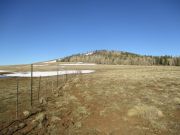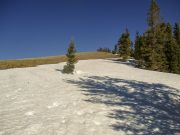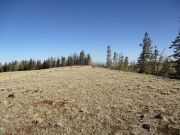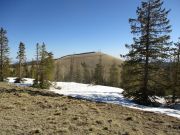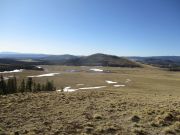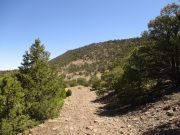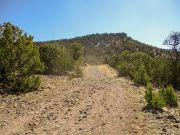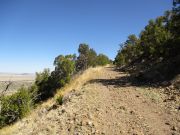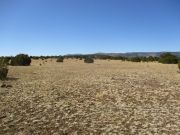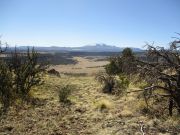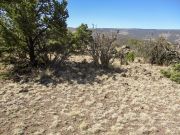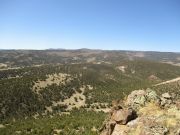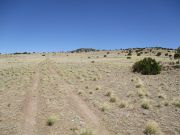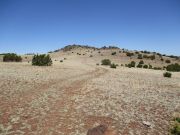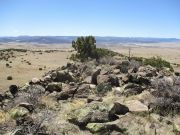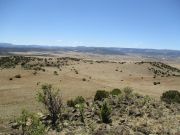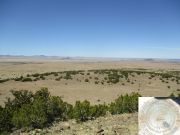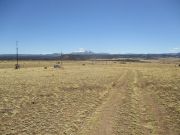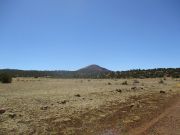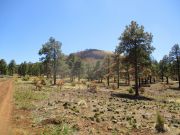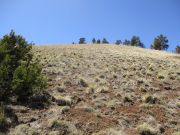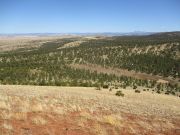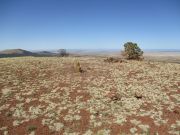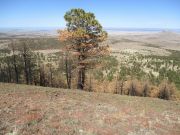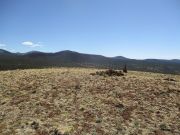
The Mountains of Arizona
www.surgent.net |
|
Grassy Top • Flat Top • Coyote Hills • Cerro Trigo Today I would hike a sampling of peaks in, on and around the Springerville Volcanic Field between Show Low and Springerville. I had four peaks on the agneda, one "high" peak above 9,000 feet, two "low" peaks near Springerville, and an in-betweener in the transition zone between the two biomes.
Date: April 25, 2020
• Elevation: 9,910 feet
• Prominence: 350 feet
• Distance: 2 miles
• Time: 45 minutes
• Gain: 350 feet
• Conditions: Clear and cool, no clouds
Arizona
•
Main
•
PB
•
LoJ
•
Interactive map
Grassy Top is the unofficial name of the 9,910-foot hill to the southwest of Greens Peak and west of Peak 9947. There's nothing special about the hill, although it is a lovely hill like all the others. Thick forest grows on its north and east slopes, while the west and south slopes are bare grass. The name "Grassy Top" may come from Bob Martin's Arizona's Mountains book. He had a penchant for naming peaks and this one seems to have stuck.
I was interested in it for one reason: it was the only 9,000-foot peak in this grouping that I have not yet climbed (not including the ones lying on the Fort Apache Indian Reservation, the boundary just a mile to the west). I was in the area last weekend and wanted to come back again, the weather expected to be warm, dry and sunny with no clouds.
I left Payson at 5:20 a.m., entering Show Low a little after 7 a.m., then up onto the highlands near the Sunrise Ski Area. There were patches of snow starting at about 9,000 feet elevation. I got onto Apache Forest Road 117, which was dry and in good shape. I drove in about four miles, parking near a corral just below Peak 9947. The shoulders were still a little muddy and sticky, as I discovered.
I started walking at 7:40, the weather cool but not cold. I walked through a gate, then immediately another gate, now outside the corral again and no longer bounded by fencing. I then walked across the grass meadow toward Grassy Top. There were patches of snow on the meadow and hillsides of varying size.
Once at the east base of the hill, I angled to get out of the trees and started up the grassy slope, coming to a big snowbank. I walked onto it and discovered it was in great shape for walking: mushy but not soft, not icy or slick, just enough to hold my steps. I walked up this bank until it started to wane. I eased back onto the grass and soon was on top the hill.
The top is grassy, so the name is apt, although a half dozen other hills here have grassy tops too. I signed into the register, tagged the cairn and a couple other rocks, and took a few photos. The sun was still low in the east so images that way came out with glare. The grass was still mostly yellow. In summer, the grass becomes very green.
I walked down the same way, even retracing most of my route down the snowbank following my own prints. I was back to my car at 8:20, pleased to get this one done. It went fast, as I knew it would. The day was young and held much promise.
Elevation: 8,167 feet
• Prominence: 507 feet
• Distance: 5 miles
• Time: 1 hour, 25 minutes
• Gain: 850 feet
• Conditions: Clear, slightly warm
PB
•
LoJ
Flat Top is a mesa in the Apache National Forest just outside the Eagar city limits. An old road goes to the top, and it has been refurbished as a hiker's trail. It is the best local hike for people living in Eagar and Springerville looking for a workout.
I left AZ-260 onto School Bus Road for a few miles, then south on Water Canyon Road to 12th Street, where there is a parking area at the corner of 12th and Line Streets, west of the peak. I was the second car in the small lot. It was 9:15 a.m., sunny and about 15 degrees warmer than on my short Grassy Top hike. It was in the mid 60s, so it was pleasant.
There's a "Road Closed" sign on a gate at the back of the lot, and a pedestrian opening beside it, then four trails to choose from. The left-most is the old road, then two actual trails, then another road to the right. I ignored the two roads and followed the trail with the most bootprints. It went east to the peak through pinon and juniper. The two trails interbraided, then shortly, crossed a road, this being the left-most road at the start. The forest service calls this the Robinson Hollow Trail. It made no difference. I simply kept to what headed to the peak and went up.
Once on the road, I stayed on it. It runs in and out of the folds of the terrain, so it takes time to make eastward progress. The grade was lenient, though, so I made good time. More toward the peak, it started to steepen, then makes a long north-trending uphill traverse of the peak's west slopes to top out on the mesa's top. To here, I had hiked a little under two miles, gaining over 800 feet.
The highpoint of the mesa is on its south tip, while the road feeds onto the north half of the mesa, about a half-mile distant. I was a little worried the top would be heavily forested and I'd have to find my way through the trees. Instead, the top is open, with low grass and pinon and junipers spaced out so that navigating was trivial.
I left the road and started walking south, aiming for a low rise in the distance. The change would be only 30 feet, and I barely sensed an uphill as I closed in on the presumed highpoint, now a little more forested here. I found a big cairn which I took to be the highpoint, but I also tagged, kicked, sidled by and glanced as many other rises and rock extrusions as I could. The views here were great, with openings to allow views to distant peaks and nearby hills and valleys.
I took a small break here, but not very long. I just slowly wandered the area, shooting photos and looking around. I walked out the way I came in, enjoying the meadowy forest. I hiked out the same route, meeting up with about a half-dozen people. Everyone was friendly and we kept our distances.
I was moving fast, and was back to my car about 10:35 a.m.. By now, it was warmer, but still pleasant. The sun can be very intense at higher elevation, making it feel warmer. My next objective, Coyote Hills, was just a couple miles to the north. I would be there soon.
Elevation: 7,810 feet
• Prominence: 550 feet
• Distance: 2.4 miles
• Time: 55 minutes
• Gain: 440 feet
• Conditions: Clear, sunny, insects
PB
•
LoJ
•
USGS BM Datasheet
I now set my sights on the Coyote Hills, a sprawling shield volcano north of Springerville. The summit rises about 550 feet above the countryside and over 800 feet above Springerville. However, it appears "low", given the surrounding slopes are long and gentle. The volanic mound covers about 20 square miles.
In Springerville, I drove eastbound on US-60 up a canyon hemming in Nutrioso Creek. The road tops out then bends to the right slightly. I turned left (north) onto the first "good" road I came to, this point about three miles east of town. The land up here is grassy and bare, with a few scattered trees but nothing tall. This is State Trust land, some of it used for grazing judging by the cows I encountered standing in the road, as they like to do.
I went north on this road for 0.7 mile, the road being hardpack with a few rocks, but uneven and rutted. I was behind some pickup trucks, so I slowed and let them do their thing. They pulled into a clearing and set up to shoot for the afternoon.
I then turned left (west) onto another road, which to my surprise was covered in old, decaying asphalt. The road was narrow, grass and brush grew out of the cracks in the asphalt, and whole segments of the road had rotted away into sand pits. I drove slowly for about 1.3 mile, topping out, then turning right (north) onto a two-track etched into the open hillside. A homestead lies to the south, and there are power lines along this track.
The track looked tolerable, so I eased onto it and drove in about a thousand feet, gaining about 60 feet, to top out on a small flat bench. I parked in a clearing near a power pole and satellite dish, to where my car was not easily visible from down below. I was a little over a mile from the top, about 450 feet below.
The asphalted road intrigued me, so when I got home later, I looked it up but could not find anything about it. The "open mapper" sites don't call it anything, but it looked too straight to be a random ranch track. I suspected it may be an older alignment of US-60, and after more digging, found a map that identified it as exactly that. My hunch was correct. I don't know when the current alignment was built, but safe to say this older road lost its designation probably 50 years ago, at least.
The day was warm and pleasant, with no clouds and an intense sun. The hike looked very easy. I was on bare open slope, just low grass and an occasional bush in the distance. I walked the road, gaining toward a ridge ahead of me. The road crests this ridge, from where the summit is visible. Suddenly, the whole place got ten times prettier. It was a little more rocky, a little more brushy with a few trees, and the whole place looked like a park.
I walked the road to where it comes to a fence line, and simply ends. There is no gate or stile to pass through. I walked up a hill and crossed the fence in a spot where it had fallen over most of the way. Beyond that, the top was just a five-minute walk. I was on top the rocky summit quickly, a half-hour hike from the car.
I found the benchmark, a witness mark, a pit of some unknown provenance, and a few small pieces of trash. I could not find a register but noted people scratched in their names onto the rocks. I don't think many people come up here, as it looked generally free of clutter. I enjoyed this perch, and spent about ten minutes resting. To the north was the massive Springerville Generating Station, a huge power plant plopped onto the flat plateau out that way. To the west were the vents of the Springerville Volcanic Field. East were hills and peaks in New Mexico, and south the forested highlands of the White Mountains. I felt a sense of remoteness up here, that "high lonesome" feeling.
I walked out the same way. Two things caught my attention. First, the bugs. The jumping kind were everywhere and bopping into me pretty much the whole walk down. The flying kind would sometimes buzz me and bop into my neck or the back of my head. Second, looking south at Flat Top, I would have sworn that I was higher where I was, yet according to the maps, Flat Top's summit is about 330 feet higher.
I was about 50 vertical feet below the summit here, so I got out my water bottle and carefully eyeballed through it to judge "level". The best I could do was to discern Flat Top was a "little higher". Yet, to my raw senses, it looked significantly lower. I think I was being fooled by the ridges that rise south of Flat Top, these being at nearly 9,000 feet elevation. I subconsciously viewed these as my horizon, thus level, making Flat Top appear lower. I was taken in by the false horizon optical illusion.
Anyway, I was soon back to my car, gone a little over an hour. I was three for three so far today, with one more peak on the agenda, a bump called Cerro Trigo up on the Springerville Volcanic Field. I had skipped it last weekend, but knowing the roads were in good shape, wanted to hike it on my drive back home. I stopped in Springerville for snacks, then continued on my way, westbound on US-60.
Elevation: 8,614 feet
• Prominence: 534 feet
• Distance: 2.7 miles
• Time: 50 minutes
• Gain: 695 feet
• Conditions: Sunny, warm, nice
PB
•
LoJ
Cerro Trigo ("Wheat Hill") is one of many symmetric humps of cinder on the Springerville Volcanic Field. It lies south of Cerro Montoso and southwest of Cerro Quemado. I was here last week hiking those two peaks, but had not planned to hike Trigo because I was unsure of the road conditions and keeping to the peaks directy along US-60 instead.
From US-60, I followed Forest Road 117 south about three miles, then FR-65 west toward the obvious conical hump (Note: the roads here are marked by Apache County Road shields, not the usual Forest Road plastic sticks. This is Apache CR 1327). This secondary road was in fine shape. It leads to the Whiting Ranch, which apparently is still an active outfit. I drove in a couple miles, not paying much attention to the odometer. Once to the northeast of the base of the mountain, I found a lesser unnumbered track that went south, as shown on the map. I pulled in about a quarter mile and parked under a ponderosa. The road was uneven and I could have driven more, but I was within a mile of the peak anyway.
I noticed a burn on the peaks northeast face. It could be seen from a distance. As I walked the road situating myself on the peak's east buttress, there were burned trees and burned grassy areas. The burn looked very recent. Later, I would look it up. This was the small Homestead Fire from October, 2019. It burned about 300 acres.
The map shows a road leaves this north-south track and wanders up to the top, and by now, tired from three other hikes, I was content to simply follow a road. I found a track that went right and uphill, figuring this to be the road. I trudged up the track, but it was steep and loose and sloppy ... then it ended. I had gained about 200 feet on this track, so I just trudged upward on the open grass slope. It was very steep but manageable. I gained another couple hundred feet doing this, but then saw the proper road off to my left. I sidehilled to it, then followed that up to the top. Once I learned about the fire and how recent it was, I think I had walked up a bulldozer path used to put in a fire perimeter.
Once on the proper road, I walked it up to the bare top. There was a single wooden power pole up here, but no wires. What its purpose was, I will never know. The top was just a rounded hump of gravel and rocks, and a couple bushes nearby. The views were nice and I snapped a few images. I walked to the edge of the burned slope and took an image of it, too. The crowns are still green but it seems a lot of these trees got burned lower down.
I took just a brief break up here. Going down, I followed the better road all the way down. It switchbacks more so adds a little distance, but it was far easier than dealing with steep slopes. I was back to my car a little over an hour after starting, a 2.5 mile round trip (give or take) hike. By now, I had put in nearly 12 miles today and was done. I drove back to US-60 then directly home, arriving a few hours later, four peaks done today! I love this area and plan to be back a few more times before the summer thunderstorms start kicking up.
|
|
